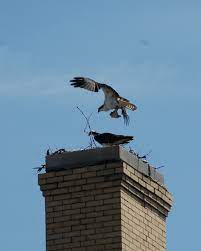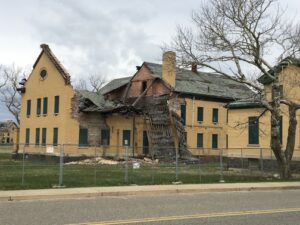Osprey or MAST … Who Will Win?
With no response from either Gateway National Recreation Area nor the Monmouth County Board of Commissioners, don’t be surprised if the $15 million plan for building a much- needed indoor drill and classroom complex for the NJROTC program at MAST, is put off once again.
Common sense would attribute yet another delay to lack of action by those in control, lack of planning by the architect, a distinct failure to learn from past mistakes and lack of communication between two public entities who contracted to build the facility in the historic district of Fort Hancock.
The National Park Service and the Monmouth County Vocational School Board of Education will most likely blame it on the osprey should construction not start as advertised.
A pre-planning meeting for the restoration of a former barracks facing Pershing Field in the historic Fort Hancock section of Gateway National Recreation Area at Sandy Hook scheduled for five days before Christmas was attended by only two possible prospective bidders to be construction manager for the project. That manager would then retain and oversee all the subcontractors for the partially collapsed two story covered porch building. Work would also include a two-story addition and an elevator for barrier-free access to all levels from the main entrance lobby and would create a dedicated facility to accommodate the NJROTC program for every student at the Marine Academy of Science and Technology (MAST).
Known as Building 23, the new facility would accommodate a shared faculty office, classrooms, a drill hall, gymnasium and locker rooms. The latest project description by Eric Wagner, the county’s architect with the firm of Kellenyi Johnson Wagner does not mention bathrooms or showers as an earlier description did.
Both the County school district and the Park Service have been this far before. The idea of converting and restoring more historic buildings for MAST to be used for academic and NJROTC programs was conceived in 2014.
Under a plan developed in 2019, $14 million was scheduled to restore Building 23 as well as the much smaller Building 56, a former mess hall built in 1905, 3000 square feet in size. New construction was designed for MAST to use as a storage facility for the more than $1 million in government issued uniforms and equipment for the NJROTC program. That building, though still needing some work, has been “substantially completed,” according to Wagner. It has enabled the NJROTC to move their equipment and uniforms from crowded unprotected trailers to the safer, more organized storage facility in the historic building.
In 2019, with both the county and the park service, as well as officers with the NJROTC Program lauding the plan for both historic and academic reasons, it was noted how the partially collapsed buildings would be restored and NJROTC cadets would not have to face frigid or extremely hot temperatures for their drills and other requirements.
However, that construction project was halted in March of that year when the ospreys returned to their nest atop Building 56 and environmental laws prohibit disturbing nesting ospreys.
In February 2020, the ospreys were gone, and deterrent devices were installed to ensure they would not return. A bid was awarded to begin work on Building 56, the smaller building. To ensure the ospreys could find safe locations to build nests in other areas of Fort Hancock, approximately 20 devices were installed on and around Building 23.
Bids were then sought and awarded for abatement work and osprey deterrents when 12 bids were received and work started immediately. Construction of the NJROTC facility was scheduled to be completed by 2022.
But once again bids were delayed, work was not done, the building continued to collapse and NJROTC cadets continued to drill in wintry weather or extreme heat. The ospreys returned, the deterrents either failed or were destroyed by weather, and an osprey nest still stands at the top of one wall of the collapsed building.
Ospreys are the exceptionally large raptors whose main diet is live fish. They are common sights soaring over shorelines or standing on their huge stick nests. They were once considered endangered but are sturdy and have rebounded in numbers following the ban on the pesticide DDT.
Ospreys frequently, if not always, return to their nest from the previous year and build it larger while preparing for another season of egg laying and chick raising until they once again migrate south, only to return the following year in an ages old pattern.
Wagner made mention of the migratory bird return at the pre-Christmas meeting, identifying the season as mid to late March when they are expected to return.
That’s precisely the same time the architect ‘s timeline for start of construction occurs.
When asked at the meeting about the conflict between the returning birds possibly returning to the nest atop Building 23, and the March 20 date he has set for mobilization of the project, he indicated he is “hopeful” that work and activity around the site will deter the birds and they will seek a quieter, more safe location for building a new nest and preparing for new eggs. No other action or deterrent was identified to be either planned or in place.
VeniVidiScripto sent letters to both the National Park Service and the Monmouth County Board of Commissioners Director Dec. 21 asking the same questions of both signers of the construction contract.
- With permission, couldn’t the osprey nest that’s there now removed before mid-March?
- In the alternative, couldn’t the County board be mandated to take immediate action either to ensure the ospreys do not come back to this nest if it’s left up there?
- For that matter, why would the NPS allow the osprey nest to stand now, knowing that with the contract between the county and the NPS the ospreys won’t be able to nest there in the immediate future anyway?
- If the NPS has granted permission to re-build #23, and since ospreys had been nesting on that site for years before the building contract was agreed upon, should the NPS take any action on its own to enable the ospreys to find another site without the trauma of revisiting and being disturbed in the future?
- Speaking for the ospreys, if the NPS agreed to have the building reconstructed to its former magnificence, knew there was an osprey nest on top, and knowing ospreys generally return to their nests each migration, we would hope you would mandate, or take the action to remove a nest before we (the ospreys I’m speaking for) all come back, happy as ospreys, and set up our homes again so the poor couple, thinking they’re coming home, aren’t shocked at the last minute! That might be disturbing to the rest of us)
To date, there has been no acknowledgement of the questions, nor any response from either the Park Service or the Board of Commissioners. The empty nest still sits atop the building that is expected, if bids are received and accepted, to be under construction March 20.
There are other questions that should be asked and answered. Why would the National Park Service and/or the Monmouth County Vocational School District, pour thousands of dollars into setting up deterrents for a nest that has to be moved anyway if the building is to be restored? Would it not have been easier, cheaper, and more sensible to simply remove the nest during the cold winter months when the ospreys were enjoying warmer climes? What justifies spending thousands of dollars to put up deterrents when there are approved historic plans is to reconstruct the building, including the one wall atop which the nest is sitting anyway?
While environmental concerns and protection of wildlife are primary duties and obligations of the National Park Service, even for recreational areas such as Sandy Hook where millions of people are encouraged to use the beach and ocean, does not the National Park Service also have an obligation to preserve and restore historic structures and national history? One might ask, in the matter of Fort Hancock and the ospreys, which should have priority?




